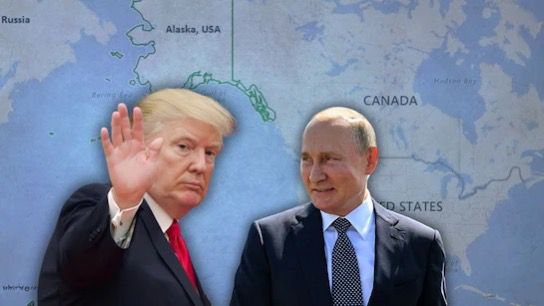Alaska: The Meeting That Could Rewrite the World’s Balance of Power
Instead of focusing on crafting a new global strategy, many Western leaders have locked themselves into the narrow political circle of domestic rhetoric. That’s why major initiatives like a US-Russia Arctic could catch them off guard, leaving them with little ability to influence outcomes.
Enri Çeno
8/13/20256 min read


The planned meeting this Friday in Alaska between U.S. President Donald Trump and Russian President Vladimir Putin is not just another diplomatic engagement with no public agenda. It will take place on territory that was once part of the Russian Empire and is now the largest U.S. state, a powerful historical symbol connecting two nations that, for a century and a half, have alternated between rivalry and moments of cautious cooperation.
In 1867, the United States purchased Alaska from Russia for $7.2 million, a deal derided at the time as “Seward’s Folly.” Back then, the territory was seen as remote, inhospitable, and of little practical value. History proved otherwise: Alaska became a strategic hub for America’s defense during World War II, a vital energy-producing region, and a key operational point for both Pacific and Arctic trade and military activities. Today, the fact that a potentially historic meeting is happening here gives the event symbolic weight far beyond routine diplomacy.
Alaska, as the meeting site, sends a quiet but unmistakable message: territory, even when it changes flags, remains a constant factor in the global balance of power. The U.S. acquired it through negotiation, but if it now uses that position to forge a strategic axis with Russia, it would prove once again that geography and diplomacy can intertwine in ways that reshape the international order.
Beyond Ukraine: The Real Game in the Arctic
In public narratives, this meeting is mostly seen as an opportunity to seek a pathway to peace in Ukraine. But for strategic analysts, the real centerpiece may be the Arctic and control over its routes and resources. Due to its unique geographical position, the region offers direct trade corridors between continents and holds an extraordinary wealth of natural resources: oil, gas, and rare-earth minerals critical for modern technology and defense industries.
For the U.S., Alaska is its only natural gateway to the region, while Russia holds the longest Arctic coastline and the most developed infrastructure in the High North. Combined, these advantages could allow the two nations to jointly control trade arteries and strategic resources, effectively sidelining major global players including the EU and China. This is why any agreement on the Arctic could carry far greater long-term weight than even the resolution of the Ukrainian conflict itself.
Control of the Arctic is not merely an economic matter, it is a direct question of national security. It encompasses the ability to project military presence at critical choke points, to monitor trade flows, and to dictate terms for the passage of goods and energy. That is why agreements over this region are viewed not as trade deals but as high-order strategic arrangements capable of setting new global balances for decades.
A Century-Old Fear in Europe and London
For over a century, Europe’s capitals and London have pursued an unwritten strategy: keep Moscow and Washington apart. From their perspective, a close U.S.–Russia partnership would mean the end of their role as indispensable intermediaries and a sharp decline in their global influence.
The historical record is clear: between the two world wars, Britain worked to maintain its power balance by preventing rapprochement between the United States and the Soviet Union; during the Cold War, rare moments of détente in the 1970s were met with unease in London and Paris. An energy and trade alliance between the two powers today would overturn the post-war architecture, replacing the U.S.–EU axis with a U.S.–Russia one in which Europe would have no decisive voice.
Europe understands all too well that losing its bridge role between the two superpowers would bring a contraction of influence in international organizations, trade negotiations, and diplomacy. If Washington and Moscow choose to act directly without mediation, the EU will be relegated to a peripheral role, forced to adapt to decisions made elsewhere rather than shaping them.
China – America’s Real Rival
While Europe views such a development as the loss of its historical leverage, the player with the most to lose is China. Beijing has poured billions into developing global trade networks and supply chains to control resource and goods flows. A U.S.–Russia deal on the Arctic would severely restrict China’s ability to expand its role in global trade and secure access to strategic resources.
Joint control of trade corridors and rare-earth supplies by Washington and Moscow would create an economic bloc capable of dictating terms to world markets. This would be a significant obstacle to China’s long-term strategy, which depends on access to raw materials for its high-tech and defense industries.
Beyond economics, China would also lose the ability to set standards and rules in polar regions — something Beijing has pursued as part of its strategy to expand political influence globally. A U.S. aligned with Russia would be far better positioned to block these ambitions.
From Consumer to Strategic Producer
The United States has traditionally been a consuming superpower, dependent on imports of critical resources. A deal with Russia to exploit the Arctic could mark a complete economic transformation. By controlling a significant portion of global energy and mineral supplies, the U.S. could become not just self-sufficient but also a strategic exporter to international markets.
This shift would increase American leverage in trade negotiations, strengthen national security, and eliminate dependence on networks controlled by rivals. In international political terms, it would give Washington a new bargaining power and sharply reduce the economic pressure that other global alliances could exert.
A U.S. that is both a major producer and exporter would upend the global trade balance, forcing even its traditional partners to recalibrate their economic relationships. This new status would make America an indispensable player at any trade negotiation table.
The West and the Decline of Statesmanship
Instead of calmly analyzing the implications of a potential U.S.–Russia deal, much of the Western world has chosen to focus on Donald Trump as an individual, attacking and trying to politically delegitimize him. This narrow fixation reveals a lack of strategic vision.
Historically, the West produced leaders like Churchill, Roosevelt, and De Gaulle — figures who shaped the architecture of the world order. Today, many of their political heirs are consumed by shallow debates over questions such as “what is a man and what is a woman,” while rival powers draft plans for the coming decades. This contrast highlights the West’s decline in producing long-term strategists capable of managing seismic geopolitical shifts.
Instead of preparing a new global strategy, many Western leaders are trapped in the narrow confines of domestic political rhetoric. This is why major initiatives, such as a U.S.–Russia agreement on the Arctic, can catch them unprepared and limit their ability to influence the outcome.
The Symbolism of Alaska: From Sale to Partnership
Alaska is more than a meeting venue; it is a historical turning point. From a territory sold for a modest sum, it has become a strategic asset and a key point for Arctic control. If this meeting produces a deal uniting the U.S. and Russia in managing the region, it would close a 156-year historical circle.
This symbolism resonates not only with the two nations but with the world: it shows that agreements which seem small in their time can pave the way for epoch-defining changes centuries later. In this sense, the meeting in Alaska could be seen as a new chapter in a story that began with a transaction and may now continue with a strategic alliance.
Holding the meeting in Alaska may be a quiet way of underscoring that borders and sovereignty are not immutable but are the product of agreements and alliances. If this land, once transferred from one power to another, becomes the foundation for a new partnership, it will set a powerful precedent in international diplomacy.
A Smaller Table, Bigger Decisions
In diplomacy, the fewer the people at the table, the faster and deeper the decisions. If Trump and Putin reach an agreement in Alaska, it will happen outside the gaze of Brussels’ bureaucracy and beyond the influence of traditional intermediaries.
Such arrangements have changed history before: the 1945 Yalta Conference redrew the world’s borders for half a century. Alaska could become the Yalta of the 21st century, but this time, without a third ally in the room. The result could be a new global order in which the old players are merely spectators.
When decision-making is reduced to a minimal number of actors, the process becomes faster but also more dangerous for those excluded. For everyone outside that room, any decision made in Alaska will be a fait accompli, requiring immediate adaptation and, in many cases, a deep compromise with the new reality.
